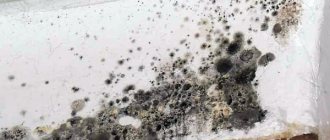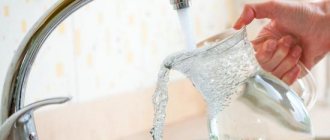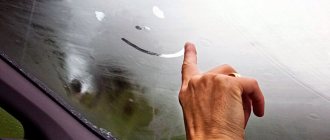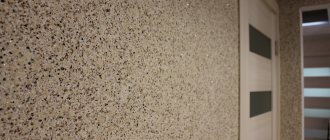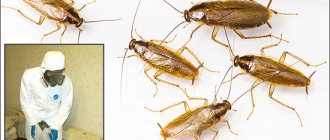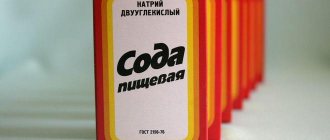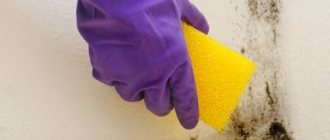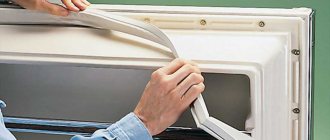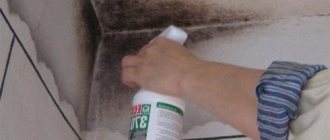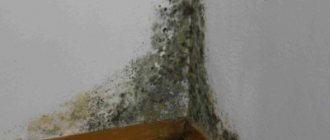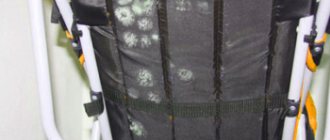Once mold develops, the room is no longer as safe or habitable. Fungus can form anywhere - on the walls of rooms, in the bathroom, in the kitchen.
An article about mold in an apartment contains the following sections:
- Mold indoors
- Mold on the walls
- Mold in the bathroom
- Causes of mold
- Mold removal
- Prevention of mold formation
Mold is a name given to various fungi that produce harmful microspores in large numbers. These organisms penetrate through the pores into the human body, land on the skin, settle in the lungs, and end up on food, which leads to chronic runny nose, dermatosis, inflammation of the trachea, conjunctivitis, bronchial asthma and many others. If toxins penetrate the circulatory system, a person’s kidneys, gastrointestinal tract, liver are affected, frequent headaches and fatigue appear.
It is important!
You can get very sick if you stay in a mold-infested room for too long.
Spores are able to make their way through the mouth and nose into the human body. The most common reaction to fungus is allergy. This disease most often affects the elderly and young children. The severity of the disease depends on the susceptibility of the body.
Mold indoors
Indoors, mold occurs in corners, on the ceiling, on the balcony and walls. Over time, this type of fungus can appear in the bathroom, on the washing machine, in the refrigerator and other household appliances, as well as on furniture.
Mold can form not only in an old room, but also in a new one. It can also occur after major repairs. The first indicators of the presence of mold in an apartment are the smell of fungus and dampness. The danger lies in the fact that it quickly spreads throughout the room, transferring to things and household appliances that are saturated with its special smell.
If fungus appears on a balcony or loggia, it is necessary to glaze them, insulate the floors and walls, and install heating and ventilation.
Most often, fungus appears in washing machines. It mainly settles in the compartment for detergents and in the rubber seal. Therefore, at the end of washing, you need to ventilate the drum and powder compartment, use high-temperature modes and do not leave wet laundry in the drum.
Why does mold appear in the apartment?
There can be several reasons for mold growth. However, often they all boil down to the fact that the ventilation in the apartment is not properly adjusted. As a result, the air exchange rate does not correspond to the value of 25-30 m³/hour per person, the air becomes heavy, waterlogged, and stale. Moisture and heat create ideal conditions for the growth of pathogenic microflora.
According to sanitary standards DBN V.2.5-67-2013, the humidity level in residential premises should not exceed 40-60%. Even a slight deviation from these limits leads to a deterioration in microclimatic parameters and provokes the development of fungus.
In most cases, solving issues of insufficient air circulation is quite simple. To do this, select household recuperators in our online catalog. After their installation, waterlogged air masses will be vented outside in a timely manner, which means that the fungus will not be able to develop.
We recommend the product
Recuperator Blauberg Vento Expert Plus WiFi 6 reviews
In stock
Heat recovery efficiency,%: 82, 90, 97 | Heat exchanger material: ceramics | Installation of external grille: from indoors | Wall module diameter, mm: 160 | Filter class: F8 (optional), G3 | Wall thickness from, mm: 250 | Area, m²: 11-20 |
The principle of operation of the recuperator in winter
Mold on the walls
Fungus can form in any part of the wall - from below, from above, or spread throughout the entire wall. If mold originates at the bottom of the wall and expands higher when the apartment is located on the 1st floor, then this indicates a violation of the waterproofing of the wall. If the wall faces the street and mold has formed on it, the wall is probably not insulated enough and not thick. The spores are not only on the surface of the walls. They are deeply embedded in the cracks. When surface treatment of walls, no solution gets into the cracks. Therefore, after a short period of time, mold appears on the walls again.
White and black mold, blue stains on the walls
White mold appears on plant pots, on the ground near them, and on the flowers themselves. It also affects kitchens, toilet surfaces, and pipes. This type of mold in the form of a fluffy coating has an unpleasant odor and is easily crushed in the hands.
It is important!
White mold poses a threat to the respiratory system and skin.
This fungus should not be touched due to very serious and deep skin damage. Black mold often affects not only walls, but also clothes, flowers and food.
Blue stains appear mainly on wood surfaces. The fungus greatly destroys them, penetrating even through a layer of paint. Dampness appears in the room, which leads to the formation of another type of fungus. This type of mold spreads quite quickly, affecting paper, organic matter and any type of wooden products.
What do owners of apartments located on the ground floor need to know?
For those who live in apartments on the ground floor, the problem of mold is known firsthand. Moreover, both residents of old housing stock (Khrushchev, Stalin buildings) and owners of modern housing in new buildings suffer from the fungus. Let's look at the main reasons that lead to blackening of walls, slopes, and ceilings.
Poor ventilation
The purpose of the ventilation system is to ensure the circulation of air masses in sufficient volume. If the ventilation ducts are designed incorrectly or fail during operation due to contamination or breakdowns, then it does not matter on which floor the apartment is located. Dampness will accumulate indoors, leading to an unpleasant odor and blackening of the walls. To organize the flow of fresh air, select wall ventilators or supply valves from the assortment of our store. Such installations are inexpensive, they are simple and undemanding to maintain, and are guaranteed to solve the problem of dampness and fungus.
Insufficient heating
In apartments that are connected to central heating, problems with dampness and mold are especially acute in the off-season. Take advantage of the services provided by Vencon if you need to adjust your heating system. This is necessary for preventive maintenance and more efficient operation of heating units.
When the temperature outside drops and the radiators are not yet heated, the air environment in the apartment becomes damp and unpleasant. As a result, condensation forms on surfaces and fungus appears over time. This situation can be avoided by installing additional heating devices. You can get acquainted with the units that our online store offers in the corresponding section. The online catalog presents modern, reliable equipment for organizing primary and additional heating.
Alternative methods of heating an apartment
Mold in the bathroom
Black mold appears quite often in the bathroom. If the air temperature is not lower than 15 degrees, the humidity is above 70%, the room is rarely ventilated and constantly closed - all these conditions are ideal for the development of mold.
The color of the mold is related to the materials used for the repair.
The fungus appears in the following places:
- Shower cabin.
- Ceiling.
- Silicone seals.
- Seams between tiles.
Causes
If you ask yourself why mold appears in an apartment, you can find out that it does not just appear, there are certain reasons for this. These include the following points:
The fungus was brought from the street by household members themselves on shoes or with their belongings.- Comfortable conditions for fungal development. Very often, mold forms in rooms with high humidity. In the apartment there is a toilet, a bathroom and a kitchen. It is noteworthy that residents of the first and last floors face a similar problem In the first case, it comes from the basement, where conditions are ideal for its existence, this is especially noticeable with poor-quality waterproofing. The second option is very relevant if the roof of the house is poorly insulated.
Causes of mold
Air humidity can rise to 90% or higher after taking a bath or shower if there is no good ventilation system. The system must operate constantly, reducing and removing very humid air. If there is a fan, the air will only be removed when the bathroom door is open. If the door is tightly closed, the fan will not do any good. Some fans turn on and off at the same time as the lights. It is not right. After leaving the bathroom, the fan should operate for several hours with the door open.
For what reasons does mold appear in the house?
Let's consider the mandatory conditions necessary for mold to actively grow and reproduce:
- If there are already mold spores in the house, which can get there through the air, through vegetables and fruits, house plants, and clothing.
- There is replenishment for the fungus from organic material. This can be wet paper, peat, soil, concrete, drywall, wood and stone.
- Conditions suitable for reproduction: air temperature from +20 degrees and above, humidity from 70 to 90 percent, poor air circulation (uneven heating of the home, faulty ventilation system, and so on).
Mold removal
To solve the fungus issue, an integrated approach is needed. It is necessary not only to wash off and clean the mold, but also to create conditions under which mold will not multiply.
Basic methods for removing mold:
- Mechanically clean the walls, ceiling, floor. Especially focus on the cracks where the fungus has settled.
- Damaged items must be disposed of.
- Carefully treat all surfaces on which mold has appeared with a special solution.
- Ventilate the room regularly.
- Maintain appropriate moisture levels.
If fungus has formed on products with pores (upholstered furniture, wallpaper, etc.), it will not be possible to clean them. It's better to get rid of them right away.
All mold remediation products are poisonous to humans. For this reason, surfaces should be cleaned using rubber gloves, having read the instructions before doing so.
Mold Removal Products
- Disinfectant primer.
- Ammonia.
- Bleach.
- Vinegar.
- Hydrogen peroxide.
- Baking soda.
What is mold and how to spot it in your home
Mold (popularly also called fungus) is one of the oldest organisms on our planet. Even cockroaches will envy its vitality, because it is known that mold spores do not tolerate the lowest temperatures, and they can travel in space without losing their basic functions. However, they need warmth and high humidity to develop. Mold that has already grown in such conditions feels great in the cold.
The basis of mold is mycelium (or mycelium), which attaches to the surface and penetrates deep into its structure. Therefore, organic matter, such as wood, becomes the most favorable soil for mold. But the fungus also develops well on stone surfaces, penetrating microcracks. What you see on the outside - a slippery dark coating, growths, fluff - is just the tip of the iceberg. Even if you wipe these formations with special care, you will very soon see them again.
When you look very closely, such as through a microscope, you can see what mold actually looks like. These are many thin long threads, at the ends of which there are tiny balls. It is in them that spores ripen - mold seeds, which are very dangerous for people and animals. They fly out during flowering, when the balls burst.
When greatly magnified, mold looks like many thin threads with balls at the ends
You can understand that mold has already penetrated into your home by some external signs:
- Food begins to spoil very quickly. This is especially noticeable on baked goods due to their specific coating and smell. Dairy products quickly turn sour or go bad for no apparent reason.
- The air in the rooms becomes stale, heavy, and it is difficult for them to breathe. It looks like the house hasn't been aired for a long time.
- The humidity is noticeably high. This is clearly visible in the condition of linen, towels and other textiles: things do not seem to dry completely, they remain damp and cold.
- The condition of the residents is deteriorating for no apparent reason. Sneezing, runny nose, and intense cough appear; eyes often water. Redness or inflammation appears on the skin, accompanied by itching. It may even lead to hair loss.
- Specific smell. It occurs when, during the growth of mold, many spores are sent freely flying through the air in a room. You simply inhale them.
Mold most often appears on baked goods
Well, if you find visible signs of mold - that same plaque - it means that the fungus has already settled in your home, and it’s time to take drastic measures.
Prevention of mold formation
It is easier to prevent mold from occurring than to eliminate it. If you eliminate the fungus, but do not adhere to basic rules, it will reappear.
Therefore, to prevent this from happening, you should adhere to the following rules:
- Ventilate the room to prevent mold from appearing on the walls and under the wallpaper. A powerful fan must be built into the hood. After taking a bath or shower, leave the door open for a couple of hours.
- Check that water is not leaking anywhere. To do this, you need to inspect all the plumbing.
- Treat joints into which moisture gets in with sealant.
- Install a ventilation valve on plastic windows with increased tightness.
- Make sure that water does not stagnate in the cup for toothbrushes, as their legs will quickly grow mold.
- Maintain the required room humidity - 30%. A high-quality heated towel rail will help with this.
- Do not place furniture close to wallpapered walls. Fungus often forms in such unventilated places.
- Before moving into a new apartment or major renovation, it is necessary to spray the walls of the bathroom with an anti-fungal agent for preventive purposes. After this procedure, you can safely install the tiles.
- If there is constant moisture on the pipes, it can cause mold to form. It is necessary to ensure that they are dry.
- It is better to dry clothes not in the bathroom, but in any other room.
On a note!
Moisture does not appear on plastic pipes.
If you follow these rules, mold will not appear. But if the fungus has spread, it is necessary to get rid of it urgently. And in the future, follow the above recommendations.
Harmful of mold to our health
Although the mold itself is located on surfaces, its spores move freely through the air along with dust. We can say that they are in constant flight. Their state is passive under unfavorable conditions. But enough dampness and heat to reach the minimum level of mold viability, the spores immediately become active, like tiny plant seeds. This results in rapid growth on any surface.
A black, gray or dirty yellow coating on walls and furniture looks unsightly. But the aesthetic side is not the most dangerous thing about the appearance of fungus. Mold constantly releases more and more spores into the air, and they contain chemical compounds harmful to the body. The result of the activity of microorganisms that distribute these volatile substances is the smell of mold.
All these substances, penetrating into the human body, over time provoke many diseases, such as:
- laryngitis;
- allergy;
- pneumonia;
- tracheitis;
- bronchitis;
- bronchial asthma;
- stomatitis;
- dermatitis;
- conjunctivitis;
- thrush;
- eczema;
- diseases of the musculoskeletal system.
Mold in your home can cause allergies, headaches and many serious illnesses.
In addition, exposure to mold causes frequent headaches, nausea, dizziness, and upset stomach and intestines. All this leads to general exhaustion of the body. The longer such exposure, the higher the likelihood of emphysema, internal bleeding and damage to abdominal organs.
Children, the elderly, and people with weakened immune systems after severe treatment are especially susceptible to the consequences of infection with fungal spores.
Video: reasons for the appearance of a tribe in the house and its harm
Features of reproduction
Reproduction of mold fungi can occur in three ways:
- asexual (using spores);
- vegetative (using separated parts of the mycelium);
- sexual.
Most species, depending on conditions, can reproduce by any of them, but not all methods are available to certain types of fungi.
If mold is in favorable conditions with sufficient nutrients and high levels of humidity, spore reproduction occurs. They develop in special storage sporangia. When the spores mature, the shell bursts. The spores are carried through the air and, once in suitable conditions, begin to actively reproduce.
It is possible that the disputes have been in an unfavorable environment for a long time. They do not develop, but remain viable. As soon as conditions change, spores immediately germinate.
In the case of vegetative propagation of a mold fungus, small parts are separated from the mycelium, which can exist independently. The development of a new colony begins with them.
Sexual reproduction occurs when the hyphae of one or different myceliums come into contact, resulting in the sex cells uniting to form a zygote. After the cell has fully matured, embryonic mycelium appears from it, which will give rise to a new full-fledged mycelium.
Conditions of appearance
Mold spores are very small, invisible to the naked eye. They are found everywhere around us - in the air, soil, on plants and objects, and are easily transported with air masses.
Where mold lives depends on the type of fungus. One prefers plants, another prefers wood, and the third prefers cereals. But the reasons for the appearance of mold are the same for all fungi. Once the spores find themselves in favorable conditions, they begin to actively reproduce.
Mold is formed due to factors such as:
- presence of a nutrient medium;
- high humidity;
- lack of air circulation;
- comfortable temperature.
As for the last point, for most fungi a temperature of +18…22⁰С is comfortable. However, some varieties in a moist nutrient medium can reproduce even at temperatures slightly above 0⁰C.
Mold removal and area treatment
Once the causes of mold have been identified and eliminated, mold removal should begin. This procedure should be carried out wearing a respiratory mask to avoid inhaling toxic spores. If mold covers small areas, you can get rid of it using washing powder, and from wood - using drying oil. In difficult cases, it is necessary to use a spatula, with which we remove mold from wallpaper or plaster.
After cleaning is completed, the wall must be thoroughly dried.
After drying, it is necessary to treat the cleaned areas with products that prevent the appearance of mold in the future. To do this, you can use a primer with antiseptics in the composition, for example:
- "Deo anti-mold"
- "Senezh anti-mold"
- "Anti-mold"
- "Mipor"
- "Anti B"
- "Capatox"
- "Homeenpoiste 1"
These or similar substances help get rid of mold and prevent it from appearing in the future. Primers should be applied in an even layer ; after drying, the wall is washed with water, thoroughly dried and re-treated. Paint or wallpaper should be applied no earlier than every other day.
In addition to the primer, you can use a solution of copper sulfate, which must be used to treat all walls. A significant disadvantage of this method will be a very noticeable blue coating on the surface. “Whiteness” also copes with this task. But you should know that the effect of copper sulfate and whiteness is not as long lasting as from special solutions, so they should be used if special antiseptic preparations are difficult to obtain.
You can also treat mold-affected and cleaned areas with urea, creazote or office glue diluted with water in a ratio of 4:1 . These substances allow you to eliminate mold for a short period of time.
The following solutions help get rid of and prevent mold from appearing in the future. The first contains 0.7 liters of vinegar, 5 liters of water, 450 grams of borax and 200 grams of boric acid. The second includes 500 grams of copper sulfate, 500 grams of sodium fluoride and 5 liters of water. Cleaned areas should be treated with heated solutions, after which they should be thoroughly dried.
What kind of mold is there?
All kinds of mold can “colonize” your home. At first glance, the only difference between them is the color of the mold. But no, in fact there are many more signs. Experienced specialists also pay attention to the structure of fungal cells.
Varieties of mold are noticeable in pictures and photographs taken on an enlarged scale: the structure of their spores may be ornate. The way the threads of the fungus are intricately intertwined with each other also speaks volumes. However, the structure of mold can only be fundamentally studied under a microscope. In the photo, it appears only as a dark spot, sometimes with a fleecy surface. What types of mold are there and why exactly are they dangerous?
